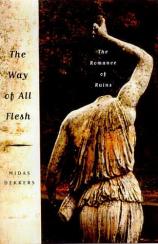The Way of All Flesh: The Romance of Ruins
Review
The Way of All Flesh: The Romance of Ruins
Midas Dekkers is
the Stephen Jay Gould of Holland, a popular biologist and writer
who illuminates the messy processes of life with the sheer force of
his lively, eminently readable prose. His latest book, THE WAY OF
ALL FLESH, puts forth the inevitable fact that where there is life
there is death. With evident glee, Dekkers piles on the evidence:
the holes in our Swiss cheese are created by bacteria farting
gasses into moldering cheese; the skin and hair on which we lavish
so much care is already dead; and even the most well-intentioned
attempts at historical preservation are misguided and often hasten
the processes of decay.
There's at least a touch of smugness in Dekkers's rehearsing of the
myriad ways in which our food, our bodies, our loved ones, and our
world are destined to crumble and return to dust. But it's to a
purpose: Western society, according to Dekkers, is obsessed with
youth --- with plastic surgery and Viagra, with beauty, novelty,
and the notion of continual rebirth. In humbler times, people saw
fit to keep memento mori close at hand: Dekkers mentions the
18th century "stairway of life" drawings; one might also mention
Shakespeare's obsession with time's fleeting arrows, or Beckett's
pithy formulation that man "gives birth astride a grave." But we
moderns prefer to look forward rather than backward, up instead of
down. Perhaps Dekkers's most hard-hitting observation is that the
so-called "gray explosion," the burgeoning populations of the
elderly in Western societies, has been foreseeable for at least the
past 50 years; but we have been collectively looking the other way
and are left totally unprepared.
Ignoring aging and death is not only unrealistic, it neglects what
Dekkers sees as the romance of ruins and the semi-tragic beauty of
decay. Dekkers makes a case for allowing buildings to fall to
pieces naturally, rather than be knocked down, and for art and
historical artifacts to be left alone. Pointing out that "where
there's death, there's life," he cites the bizarre story of how,
when the British Museum was bombed in 1940, silk tree seeds brought
from China 150 years earlier spontaneously began to sprout, sparked
to life by the hoses of the fire brigade.
It seems appropriate that this book was written by a Dutchman; even
during their Golden Age, the Dutch weren't able to feel immortal,
knowing that their low lands could at any time be reclaimed by the
sea. Dekkers possesses the wry wit and lack of pretensions of the
best European intellectuals, and the English translation by Sherry
Marx-MacDonald is nearly flawless. While it's not exactly an
uplifting book, THE WAY OF ALL FLESH is strangely satisfying,
offering a palliative to our culture's obsession with the next big
thing by reminding us of the fragility of all things.
Reviewed by Martha Hostetter on January 24, 2011
The Way of All Flesh: The Romance of Ruins
- Publication Date: October 25, 2000
- Genres: Nonfiction
- Hardcover: 256 pages
- Publisher: Farrar, Straus and Giroux
- ISBN-10: 0374286825
- ISBN-13: 9780374286828



